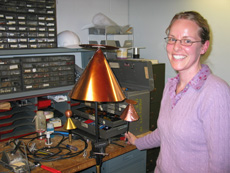A simple plan to spot leaks

Amber Johnson is welding copper cones to be used as antennas.
Beauty is in the simple, not the complex. At a lab that uses some of the most complicated machinery in the world, the simplest instruments have a novel elegance. Amber Johnson, in the Accelerator Division, constructs monitoring equipment made of two basic ingredients: a disc and a cone.
"Anyone at home can make these. They're so simple," said Johnson. "All you need to know is the frequency you are working with to know the size of the cone you need."
The High Intensity Neutrino Source accelerates particles by radio frequencies. Leaking radio waves could damage the machine. What is the perfect tool for spotting a leaking RF cavity? A radio antenna of course.
Johnson is welding copper cone and disc antennas. The cone collects the radio waves and the disc transmits them. The copper is a good conductor. To capture a radiowave, the cone-length must be at least one fourth the wavelength. Cones of different sizes detect different frequencies--smaller cones are sensitive to higher frequencies for example. If the signal is too strong a switch will shut down the accelerator.
Radio antennas are already in use in the Linac. However, for Johnson, this is her first encounter with them. She started as an electronics technician in the Accelerator Division two months ago, after working as an accelerator operator at Fermilab for three years. "It was a good project to start with," she said.
While Johnson is pleased with her little "family" of copper antennas, her affection has not spilled over in to her personal life. "Since I've begun making these, I've been asked a couple times if I want to join the ham radio club," she said. "So far I've declined."
--D.A. Venton
|